Trail running with your dog can be an awesome way for you to both get some quality exercise, as well as bonding time together out in nature.
We have really enjoyed introducing our dog Kepler to trail running and in this post, we share everything we have learned to be able to do just that.
Many people have asked us (often on our Instagram) for tips and advice on how to run with your dog, and we truly wish a post like this existed for us to read when we were new to trail running with our own adventure dog.
In this article, we’re covering everything from what you need to know beforehand, technique for running with your dog (especially when you’re on a trail), essential dog running gear, how to handle creatures and potential hazards when trail running with your dog, as well as how to care for them after a run to help them stay strong and recover quickly.
What you need to know before you go trail running with your dog
This post assumes that you’re already a trail runner and are researching what you need to know before you take your dog running with you.
If you are new to trail running, you may find our other posts such as our comprehensive ‘beginner’s guide to trail running‘ useful reading to help you prepare to hit the trails.
Your dog’s build, physical ability and fitness level to be able to run safely with them
The starting point when planning to take your dog trail running is to be satisfied that your dog is physically capable of running and spending time on the trails without putting them at risk.
A checkup at the vet should help confirm that your dog is ok to run with you on trails and does not have any underlying conditions or risk factors that may be exacerbated by this exercise.
While there are certain breeds of dog more suited to trail running (they tend to be the more athletic sporting dog breeds in the hunting and herding classifications), most breeds and mixed / unknown breeds of dog can run with you if they’re signed off by your vet as being in good health and able to do so.
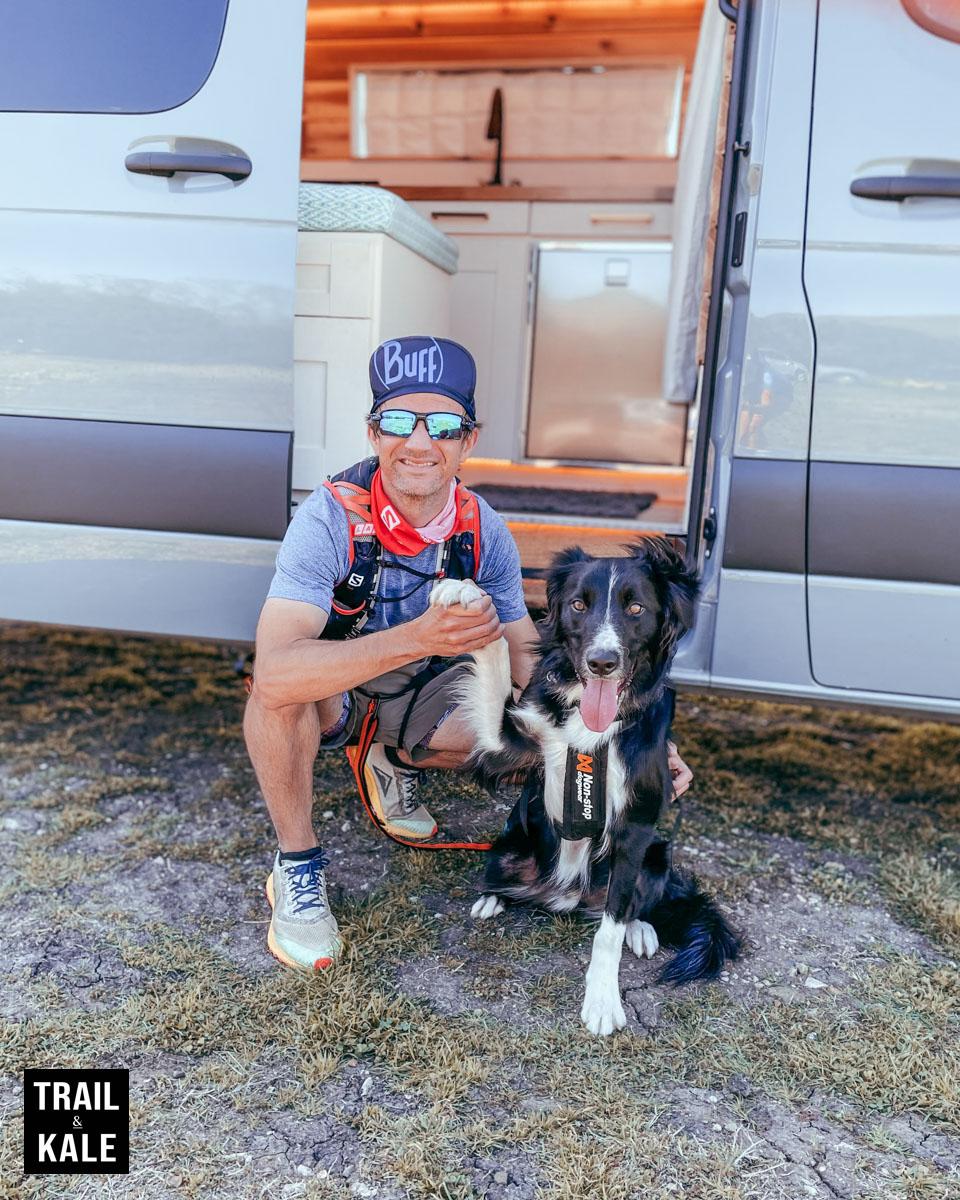
Build up your dog’s stamina and endurance
Just as with people, it’s not good for your dog’s health to take them on a particularly long, hilly, or fast run when they haven’t even been trail running before or built up their physical endurance sufficiently.
Even if you go running with your dog already on the pavement around town, as we trail runners well know, running on trails can be more strenuous and work different muscles to the more consistent repetition of road running, so some common sense and patience is required to train your dog up to the level you want them to be at to run with you on trails.
If you’re serious about building up your dog’s fitness, you could also look into getting (or finding someone who has) a dog treadmill (yes, that’s a thing).
Can I take my puppy running with me?
You may also be interested – or even dismayed – to know (as I was), that for most dog breeds, the recommendation is that puppies do not run any significant distance or frequency until the age of one year.
Sometimes the recommendation is that a puppy should not be taken running until they are even older than that, because for many dog breeds, puppies’ joints are still forming during this time, and excessive repetitive exercise has been known to cause joint issues that may not show up until later in their life.
Your dog’s vet can provide specific advice on when is ok to start running with your dog if they’re still a puppy or young dog.
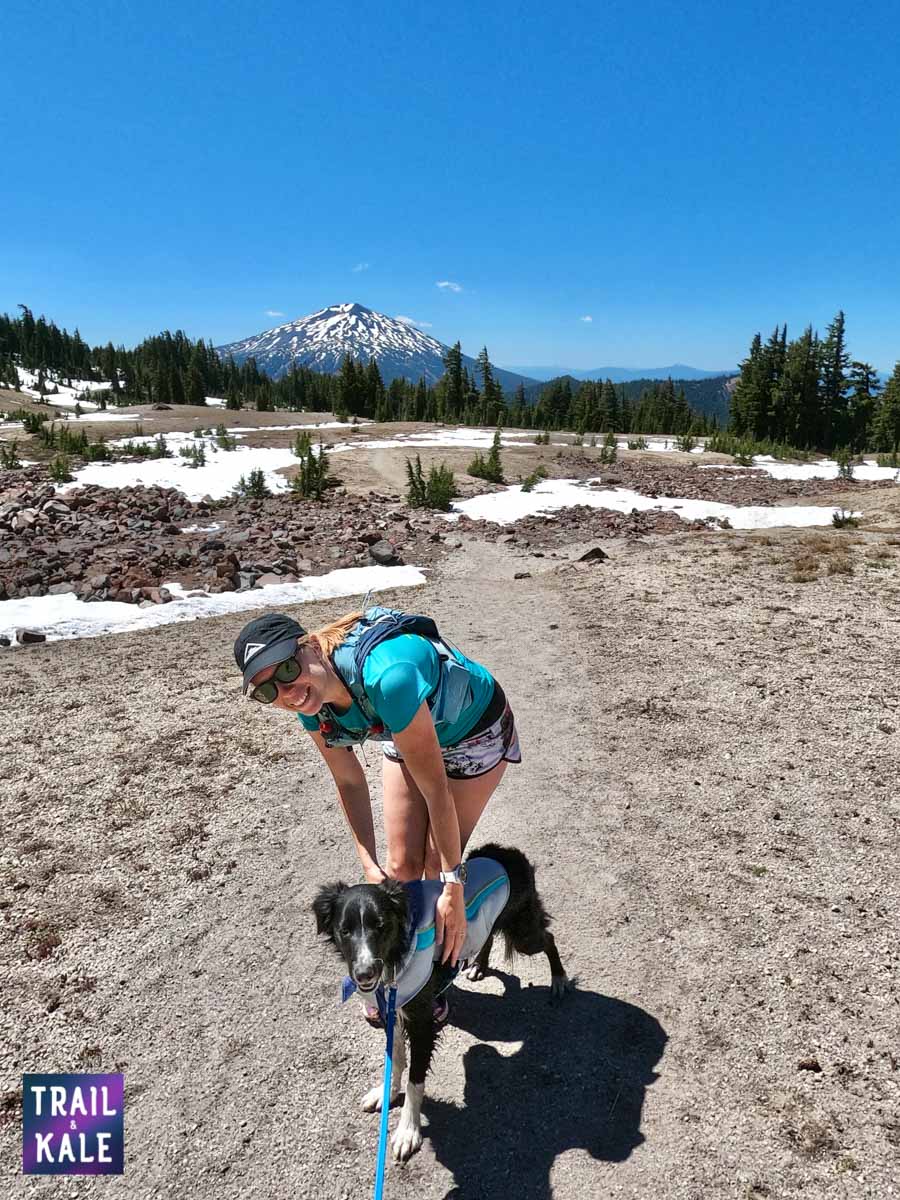
One of the many great things about going for a trail run with your dog compared to road running, is that you are naturally going to vary your speed, and have the perfect reason to take breathers and short breaks, so your dog can cool down and have a drink and possibly a snack before you get moving again.
We started taking our dog Kepler on short trail hikes when he was an older puppy, and when we started running him we gradually built up his running distance and frequency. He initially found it hard to run with us for any period of time AT OUR PACE.
Our young dog was perfectly capable of running twice as fast as us, and twice as far on a typical run, but that’s usually in bursts of fast running and then stopping to sniff. So it took training to get to the point where we could run our dog Kepler at our pace, more consistently.
Like with most things we’ve trained our dog to do, it takes time and patience to get them to the level you want when it comes to running with them.
How long (or far) can a dog run?
Some dogs may not be suited to running for several hours at a time, but may really enjoy 10, 30 or 60 minutes until they’re ‘done’.
Other dogs, like our dog, may think they can run for hours, and eventually, after enough careful training they could do so safely, but actually, it’s our responsibility to know when to call it a day and not to over-train our dog.
Asking how far can a dog run is probably not the right question – it’s more how far ‘should’ YOUR dog run at their current age and level of health and fitness.
Fun fact, a working Border Collie can run up to 50 miles in total in one day, while working herding sheep. 50 miles!
So if you’re wondering how far can a dog run, that’s a long way.
It doesn’t mean they should run that far, though, and they certainly have breaks and run in bursts at their own speed, rather than trotting along next to a person for hours and hours at a time.
Something we have learned from Day 1 of having Kepler is that giving too much exercise to a dog that doesn’t know how to ‘switch off’ and chill out is one of the biggest mistakes you can make with a young, energetic dog – if you do that then you’re essentially training a super-fit adrenaline junkie who doesn’t know how to relax.
So we actually spend a lot of time teaching our dog to chill out and take naps, rather than indulging him in endless stimulation and physical exercise.
Preventative vaccinations and medications against infections and bugs for hiking and trail running dogs
The vet may also recommend certain vaccinations and preventative medications for your dog, which can be especially important if you are taking them running with you.
For example, in addition to his regular vaccinations such as rabies, our dog Kepler takes a monthly preventative flea and tick repellant, and also a heartworm preventative, to reduce his risk of picking up any of these while out on the trails (heartworm is transmitted via mosquitoes in our part of the world).
Technique for running with your dog on trails
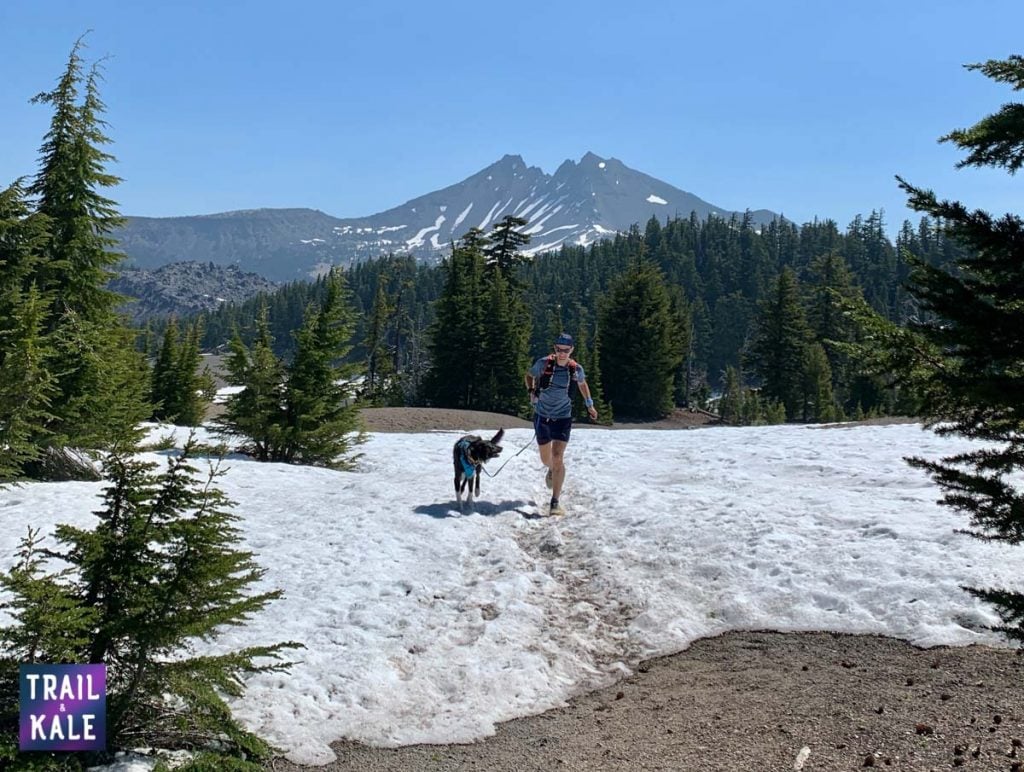
Working out a good technique for trail running with your dog is important. Running your dog along trails is very different to running on the sidewalk.
For starters, the trail is likely to be much narrower, winding, and covered with obstacles to step on/over or go around.
So that nice heel that you’ve been working hard on during your neighborhood walks is just not always practical when trail running with your dog. Believe me, I know.
t gets very difficult and confusing for your dog if you try and have them run next to you in a heel where there really isn’t the space for them to do that, they may trip over something, and – because they’re so close to you, you may well trip over them!
The most practical technique for trail running with your dog will depend on you, your dog, your experience running together, and the type of trails you are running your dog on.
For us, the most practical technique for trail running is often to have our dog Kepler run in front of us, which is what he instinctively wants to do anyway.
The one big caveat to this is that he does not pull on his leash, and when we ask him to come back and heel, he does just that.
We (and our dog trainer) worked very hard for a long time to get Kepler to the point where he will walk and run without pulling, so we can’t let him just start pulling the moment we go somewhere exciting.
So we’ve taught Kepler that when we run on trails, it’s ok to run in front, but he can’t pull. We also taught him the commands ‘close’ (aka ‘stay close’) and ‘slow’, which means he can run near us, but no further than a given distance (the equivalent of the end of the leash), before we will call him back to be ‘close’ or to ‘heel’.
This has been really important to differentiate between a walk in the heel position, and a run where he can be ‘close’ but not at our heel.
It is also possible to train your dog to run or hike behind you, which is great if you are able to train them to do that! This isn’t something we have trained our dog to do – yet, but it is a good idea.
The advantage of this is that you are more likely to be the first person to encounter another person, animal or obstacle on the trail.
The disadvantage is that you don’t have your eye on your dog like you would if they were ahead of you, and it’s not that practical for them to run behind you if they’re on-leash.
The essential dog running gear for trail running
The following items are all those that we consider being essential dog running gear for trail running in particular.
Much of your dog’s everyday gear may be fine for trail running with, although dedicated gear designed to be used for running or hiking on trails have certain advantages over regular everyday dog gear – so it’s worth investing in if you plan to go trail running with your dog often.
Leash and collar
We generally use our dog’s regular leash and collar when we go trail running.
The exception to this is if we are running him somewhere where there is a heightened risk of one of us (dog or handler) slipping off the trail or having to stop suddenly.
An example of this is where there may be a slippery wet/muddy/snowy slope to traverse, or where there are big rocks to climb that he can hop up on to but I may need a few seconds to scramble up behind him.
This is one of the main reasons we also have Kepler wear a harness, so we can switch his leash over from his collar to harness when needed. This is for safety, as we don’t want him or us to accidentally choke him or hurt his neck.
Another option, if pulling isn’t a concern for you with your dog, is to get a leash with a bungee section which has some ‘give’ in it and you can use with either a flat collar or a harness.
Some people like to attach their dog’s leash to their body in a canicross style, either using a leash designed to go around your waist, or by using a human waistband that connects to a bungee leash.
For some types of runs and terrains, this is great because it means you can run with your dog hands-free, and you get the added benefit of dog-power for your uphill climbs (although watch those downhill speeds!!).
For more challenging terrain and single-track trails, which are the trails we generally prefer to run, we like to have the option to let go of the leash if we need to and have extra control over him when necessary, for example, if I trip and fall when running, I can let go of the leash if I think it would hurt my dog to keep hold of it.
This is our preferred combination of dog running leash and harness. I know that when I stop or am hurt he stops and comes back to me. If the leash was to be around my waist or attached to me then I wouldn’t have that option.
Dog running harnesses
If you plan to run with your dog wearing a harness, trail running with a dog using a ‘canicross’ harness setup, which involves a specifically-designed pulling harness, a bungee leash and waist belt for the human to attach the leash to, is a great option for less-technical trails.
The difference between the canicross harness and a regular dog harness is that it is designed for pulling and produces less strain on the dog’s body because of the design and padding, including noticeably that the attachment point is at the end of their back rather than in the middle.
It’s also worth noting that a more minimal ‘strappy’ harness that’s fine for walking around the city may not be comfortable for the sort of movement we are asking of our dog when he runs on a trail – it depends on the dog, style of harness and amount of running you’ll be doing.
An example of a good dog harness for a dog that doesn’t pull is this smaller, padded harness made by Ruffwear, that is designed for use on trails and is comfortable for him to run and move in, gives us the option to attach a leash, goes on and off easily and can be used to grab him if we need to.
You can see some pictures and video clips of Kepler as a puppy wearing this Ruffwear harness in our Front Range Harness review, and more recent pictures of him in it on our Instagram account.
For more recommendations on the best dog leashes and harnesses for running, read our dedicated gear guide to dog leashes and harnesses for running.
GPS dog collar to track your dog’s location and steps
While a GPS dog collar can be a more costly addition, we strongly recommend having your dog wear a GPS collar if they are going to be out somewhere wild with you – and especially if you plan to let them off-leash (in approved off-leash areas) – the possibility of them getting lost and/or hurt is real.
Kepler always wears his Fi GPS collar in addition to his training collar when we go on walkies and run trails.

In addition to the peace of mind, it allows us to track his activity and step count.
Tracking his step count is great for a few reasons – we love it because we can monitor the amount of activity he is doing, and check whether he’s doing too much or not enough compared to our expectations – we don’t want to over-train him!
Equally, it’s fun comparing him against other dogs and dogs of his breed, in the Fi rankings – which is like a basic doggy Strava.
If you’re interested to know more about this dog GPS, have a read of our Fi Collar review, or visit the company’s website:
Poop bags and means of packing it out
To leave no trace and respect nature and other trail users, always pick up and pack out your dog’s waste.
It’s not good enough to send your dog off-trail into the woods, and don’t even get me started on people who bag up their dog’s poop and leave the bag on the side of the trail to ‘pick up later’.
Even if collecting it on your return is your intention, you may forget, and in the mean time, no other trail user wants to have their experience in nature enhanced by the presence of your bag of dog shit.
That said, it does suck to have to run with a bag of dog mess on you so it helps to have a secure pouch to put the bag in and stash away safely without risk of it bursting or ripping.
I use my running hydration pack and an old treat bag for this purpose. A running-specific pack like this is the Number 1 way to carry all your (and your dog’s) essentials, including water and your phone.
Water, bowl and snacks
If your dog is anything like mine then they will almost certainly drink more than you do when you take your dog running.
Not surprising considering they can only sweat through their paw pads and most are covered in a fair amount of thick hair.
Therefore even if you don’t think you’ll need much water yourself, your dog probably will, especially on a warmer day, so you need water for them as well as a collapsible or folding bowl.
Ruffwear offers a range of lightweight collapsible dog bowls for just this purpose, and you can find low-cost alternatives on Amazon.
To carry enough water for you both when you go running with your dog, I strongly recommend investing in getting yourself a good running hydration pack (Men’s options / Women’s options) that can carry a couple of bottles and/or a water bladder with enough volume.
A hydration pack also has plenty of pockets for all the other stuff you and your dog may need – the aforementioned poo bags and waste, dog snacks for your halfway / summit break, and first aid kit (more on that, below).
Potential hazards when trail running with your dog
We’ve written previously about some of the potential hazards for people when trail running – most of which can be overcome by being prepared and exercising common sense and good judgement.
All of these also apply to your dog – and some, even more so, because your dog will not (at least verbally) tell you that they are overly tired, overly thirsty or have a thorn in their paw, so you need to pay attention to them, what they’re doing and their body language so you can pre-empt their needs when you run with them.
Hot Dog – Heat risks when running with your dog
Unless it’s a cool, overcast day, consider the risk of overheating, dehydration and sunstroke. We try to choose trails that have a good amount of shade for running our dog, both to protect Kepler from the beating sun and also to ensure the ground doesn’t become too hot and burn his paws.
It’s also great if you can go trail running with your dog somewhere near a water source such as a lake or river, so there’s always somewhere to cool them off (assuming they’re allowed to go in).
You can also invest in a dog cooling jacket, such as these from Kurgo and Ruffwear, and paw wax such as Musher’s Secret can help, too.
Kepler absolutely loves putting on his cooling vest when he starts getting too hot during a run – it’s amazing how revived he seems as soon as it goes on!
Cold is a different matter…
Every dog is different but generally, any animal not used to regularly walking on snow and ice is going to be at risk of getting overly cold paws and also potentially cutting them on sharp, cold ice edges if you take them out running in cold winters.
Applying Musher’s Secret to their paws helps, as can wearing dog booties, although they do take some getting used to before your dog is likely to comfortably wear them to hike or run in.
For tips on choosing boots for your dog, head over to our dedicated dog boots buyer’s guide.
Dog injuries when trail running
As most people’s dogs are going to be running with naked paws the most common physical hazard when you take your dog running, aside from temperature-related issues, is an injury to a paw.
This is generally pretty obvious if your dog starts to limp or favor one of their legs while running.
To help keep Kepler’s paws happy when he is running, we try to seek out softer forest trails over rocky trails as these are softer on his feet, as well as on ours!
Dogs are also more susceptible than their humans to small critters such as fire ants and ticks, especially when you’re running your dog on trails.
To avoid the creepy bugs we use Kepler’s leash to keep him out of long grass where ticks generally hang out. If you’re not familiar with ticks and the hazards these pose to people as well as animals, read this post.
Foxtails are a danger to dogs in some parts of the world. These are sharp, dry grasses that can get stuck in various parts of your dog and because they’re barbed, they’re nasty as they tend to work their way into the body and cause potentially very serious damage.
Fortunately, in most places we have been I generally only find foxtails next to the trail, rather than on it, so we have found that by keeping our dog moving and on a leash when running him lowers the risk of him picking any up on his paws or in any other part of his body.
Other wild or domestic animals on or near trails
Mammals that are not threatening to people may still pose a potential threat to your dog’s wellbeing if they are something your dog may be inclined to chase – for example deer, squirrels, or domestic animals such as horses and cows.
Horses may get spooked by dogs (which can be very dangerous for everyone involved), and cows have been known to actually chase and stampede dogs and their owners.
Perhaps also the most common threat to your dog when you are running them is the possibility of another dog approaching them off-leash and not being called back by their owner.
The chance of interaction with other animals is one of the many highly important reasons why it is important to be confident that you can control your dog in the presence of significant distractions – for their safety as well as that of the other animal(s) and natural habitat that they may potentially go trampling in if they start to chase something.
You could also consider carrying a small can of Pet Corrector spray in case a random off-leash dog was to rush up to him while we are out on the trails – a spray of this should deter them while causing no harm (it is not pepper spray – it just creates a repulsive noise!), and it should work on coyotes, too, in the unlikely situation you are approached by one of them.
How to know when your dog is tired on a run
By knowing your dog and keeping an eye on their behavior and body language when you run with them, it should be pretty obvious when your dog is starting to get tired during a run together.
Like people, an individual may show this differently, but some common clear signs that our dog shows when he’s tired are a combination of one or more of these:
- His breathing – he’ll have a very long, floppy tongue hanging out and take more than a couple of minutes to stop panting when we rest during a run (this is definitely the same for me when I’m tired on a run, haha). His breath also stays very warm when he’s getting tired or a bit too warm.
- His eyes go a bit ‘wild’ – we learned this when our dog was a young puppy that when his eyes get a bit squinty or he looks a bit wild, then he is getting tired and it’s time for a nap or at least a rest. Now he looks like that when he is tired on a run and needs to call it a day. I like to think of it as his ‘ultrarunner’ look – I’ve seen many people with this look while supporting and racing at European ultrarunning festivals like UTMB, Ultraks and Lavaredo Ultra Trail 🙂
- He starts running alongside or slightly behind us – basically, if our dog is doing this during a run together then he is flagging that he’s getting tired and isn’t as excited about continuing to run. We’ve all been there…
Dog first aid when trail running and hiking
It’s good to be prepared with a small doggy first aid kit when trail running with your dog. Generally, bandages that you’d use on yourself can be used on your dog, so you can double up with your personal trail running first aid kit also being dog-worthy (what do you mean you don’t have a trail running first aid kit?!).
I also carry styptic powder and a dog-friendly first aid ointment with me as well as other accessories that I would use on my dog if I needed to give him first aid during a run, such as my Buff headband.
You can also buy a dedicated dog first aid kit which makes deciding what to pack for running with your dog much easier.
Incidentally, the risk of my dog being injured and me having to carry him off a trail is another reason he wears a harness when trail running. With the harness on, I can lift half of his body by grabbing the top.
While the harness is not designed to be used to lift him up, if I put an item of clothing or my hydration pack around his lower half, then between the harness and the hydration pack/clothing I can create a way of supporting and carrying him, if something was to happen.
You can also buy dedicated dog rescue harnesses if you feel you may need one of these to extract your dog in the event of an accident.
Encountering other trail users when running with your dog
Just as when hiking or everyday walking, good leash manners and trail etiquette are important.
Not everyone likes dogs or wants someone else’s dog approaching theirs, so the best course of action is to give other trail users plenty of space, stop or move widely out to the side (if there’s space), and let them pass.
Often, if you are trail running with your dog, other people may voluntarily step aside as you approach, and allow you to run past them, even though technically they have right of way, as this can be more efficient and less awkward all-round as the chances are that because you’re running, you’ll pass them quicker than they would have passed you. However, definitely don’t assume or expect anyone else to stop or give you the right-of-way.
As with most things trail-running related, common sense and good judgment goes a long way.
Knowing your dog’s limits, where it’s appropriate to take them and what he or she isn’t comfortable with is important.
In our case this currently means we choose not to go trail running with our dog anywhere we are likely to encounter horseback riders, or bicycles on a narrow trail.
Our dog has not had experience with horses yet and doesn’t like being close to bicycles, so we avoid putting him in the position where he may spook a horse or get worried about bikes whizzing past him.
Having had too many challenging encounters with off-leash dogs on busy/popular trails, we try to only take our dog running early in the morning and on quieter trails, where there are likely to be fewer people around.
If you really want to avoid other people altogether when you run your dog, going on trails early in the morning AND when it’s raining is a great time to get out. Although, it pretty much guarantees you will need to bathe your dog after your run 🙂 See below for more on that!
Running with your dog off-leash
Some trails allow dogs to use them off-leash. However, that still means they need to be under the owner’s control.
This is a whole subject in its own right, and not the topic of this post – because while you can do your very best and keep your dog under control while they are off-leash, often the issue is other people’s dogs coming up to yours.
Depending on you and your dog’s history, this may be a non-issue, or it could be the last thing you want to happen.
So the best we can do as trail users and dog owners is to make sure our dog, if they go off-leash, is under control, comes when called and doesn’t bother other trail users or wildlife – which takes a lot of training.
If you have your dog off-leash when you run with them it is so important that you can call them back and hold or leash them when you start to approach or see other trail users, ESPECIALLY people with their own dogs – to keep your dog safe as well as helping other trail users to enjoy their time on the trails.
Some people may be working really hard to keep their dog calm in the face of distractions, and a sufficient distance away from other strange dogs. So the last thing they need is someone else’s off-leash dog running up to them when they themselves are leashed – this could potentially trigger drama that nobody needs.
Other useful dog running gear for trail running
As with human trail running, while you can get by and have fun with the basics, there is a whole range of cool gear out there designed to make trail running with your dog a great experience for you both.
This dog gear is all perfect for trail running and worth looking into depending on the amount of running you intend to be doing with your dog, and where you’ll be going.
- Backpack with top handle – if your dog wears a backpack then they can carry their own food, water, and poop – and the handle allows you to lift your dog over obstacles if necessary. Be careful with weighing them down, though, as they’re not supposed to carry too much weight to avoid injury and strain on their body
- Core cooling vest – ours have been invaluable for hot summer trail runs with a thick-coated, dark-colored dog. You can read more about this in our reviews of the Ruffwear and Kurgo cooling vests we have for our dog.
- Waterproof and/or windproof jacket – for cold and/or wet winter runs. Our Border Collie technically shouldn’t need a jacket but he looks so sad when out in the rain that at least a waterproof jacket cheers him up as well as helping stop him getting too cold.
- Booties – to protect paws on hot, frozen and/or rough ground, and also have them look insanely cute
- Goggles – to protect eyes from snow and water reflections, dust, and dirt. Also to up the cute factor some more.
Caring for your dog after a trail run
What’s your personal post-trail-run routine? Mine goes something like this: cool-down stretching, drink water, eat, have a protein shake, update Strava, take dirty shoes and clothes off… then depending on where I am, drink cold beer/booch or have a shower and massage CBD balm into any sore spots. That’s how I look after myself after a trail run!
Well, it’s a good idea to have a post-trail-run caring routine for your dog, too. It all takes time but we believe it’s important that if we expect our dog to run trails like a boss athlete that he is treated like a boss athlete after the workout 🙂
So here are some recommendations for how to care for your dog after a trail run together:
Have him relax while you check for cuts and hitch-hikers
Ensure your dog has access to plenty of cold, fresh water and shade to chill in, and while they’re chilling and still panting, inspect their body, and in particular their paws, for hitch-hikers – specifically, ticks, foxtails, burrs, little stones, etc – our dog tends to pick up grasses and stones between his toes and in his inner thigh area.
While you’re looking at him/her, check for injured paw pads and nails, as well as other scratches on the rest of their body that they may have picked up and not even noticed while running.
Doggy sports massage
Don’t tell me my dog is spoilt, haha. One thing that we continue to work on with our dog is ensuring he is comfortable with handling.
He used to be VERY sensitive about having his front paws touched, for example. So, to help with this training, as well as genuinely help him recover after a run, I give him a massage.
I rub his shoulders, his back, hips, legs, and paws. Not like a scruffy ‘atta boy’ type of rub, but a thoughtful massage, in slow, circular motions. He LOVES it.
He’s even growing to enjoy having his paws touched – for this part, our trainer started us on some conditioning exercises where we ask him to give us his ‘paw’ and in return for letting us his paw, he also gets a high-value treat.
As we work on developing our relationship with our dog, I truly believe that the doggy massage helps us bond, and is also handling training, so it’s doubly worthwhile.
I know if I had the time and money, I’d be wanting a nice sports massage after a tough trail run. I’m living vicariously through my dog, it seems 🙂
Bathtime after a run with your dog
Chances are, your trail running dog is DIRRRRTY after a run. We don’t always wash our dog after a trail run if the dust brushes off and he didn’t get really wet or run through anything stinky. But we do try to wash him at least once every couple of weeks in any case.
While washing your dog, it’s easier to find any remaining hitch-hikers and helps to remove loose fur and undercoat. We also use this opportunity to inspect his ears more closely.
While washing him, we usually also brush our dog, and then brush him again after he’s shaken himself off. We’ve found this process really helps to detangle areas of long hair – which for ours, is mainly his floofy tail.
The bath also really helps cool him down if we got very hot during our run, and because the shampoo we use smells wonderful (of fresh apples, if you’re interested), we have a very nice-smelling dog for a few days thereafter.
Extra protein for post-run recovery
The final stage of our spoilt trail-dog / boss athlete post-run routine is basically to ensure he’s eating enough high-quality food.
It makes sense that if we benefit from a protein shake after an intense workout, to help repair our muscles, then our dog should benefit from it, too. That, and obviously most of a dog’s diet should be mostly animal protein anyway.
So I feed Kepler more on days where I’ve taken him running, including giving him something nice and meaty to chew on after a run if it’s not quite dinner time yet – that’s usually a bully stick or something equally tasty and digestible. We also regularly give him dog-specific CBD oil and treats, which you can learn more about in this post.
At the end of the day, just like with your own post-workout routine, how much you do for your dog after a trail run can be as much or as little as you feel necessary – you may not stretch or have a protein shake yourself, and that’s fine.
Equally, you may not feel it necessary to do some of the things mentioned here. But this is what we do, and it makes us feel good about caring for our dog!
We’d love to hear about your experience of trail running with your dog – including technique, their breed, how you like to keep them cool and safe while on the trails.
If you have any other useful tips or insights that you’d like to share to help this guide be the best possible guide to trail running with your dog then please share with us and our other readers by dropping a comment below!


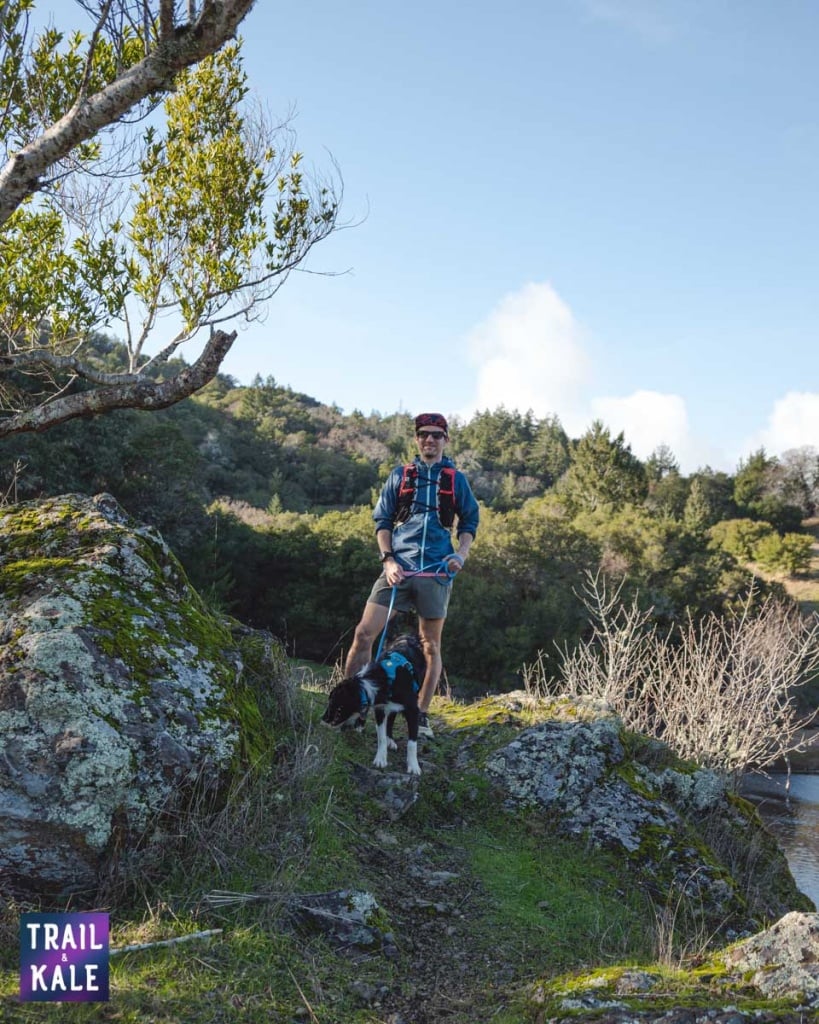
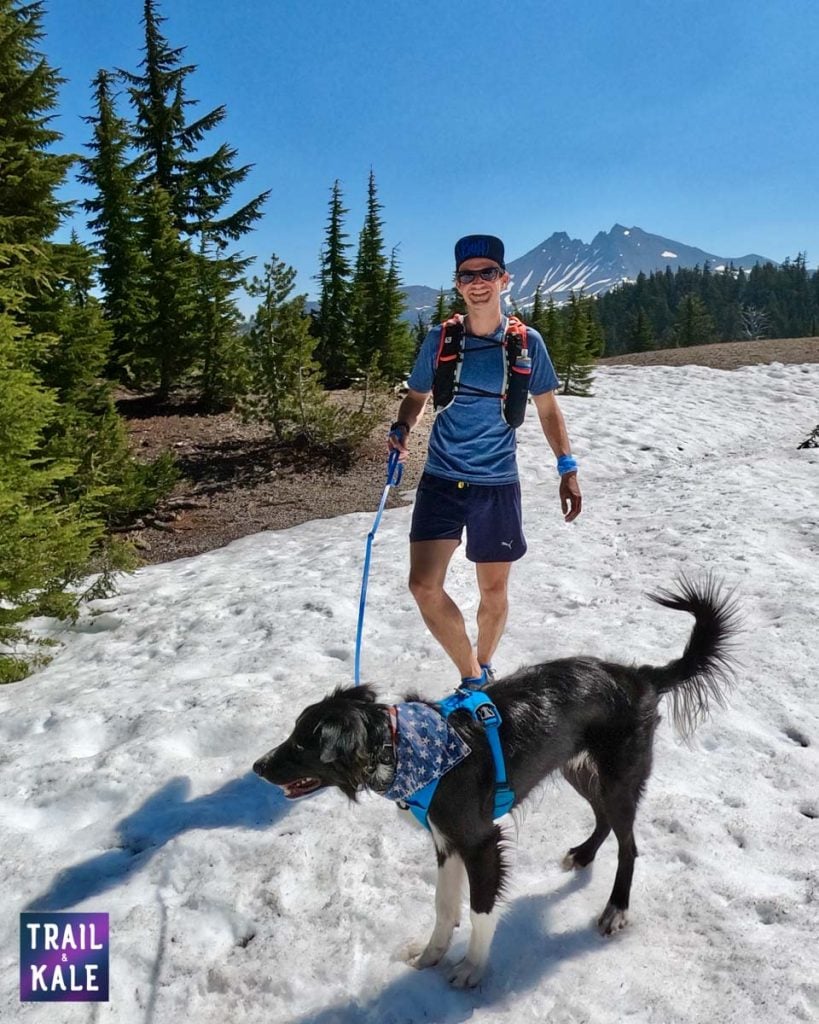




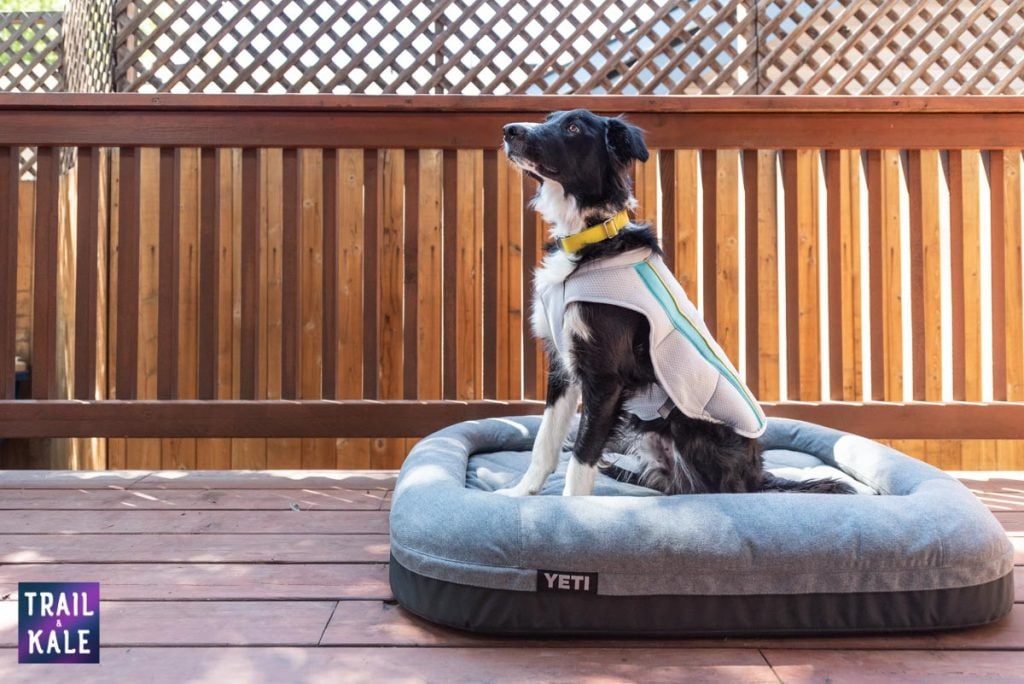



![14+ Best On Running Shoes [2024] Ranked With Reviews: Ultimate On Cloud Buyer’s Guide 14+ Best On Running Shoes [2024] Ranked With Reviews: Ultimate On Cloud Buyer’s Guide](https://www.trailandkale.com/wp-content/uploads/2024/05/Best-On-Running-Shoes-of-2024-110x75.webp)
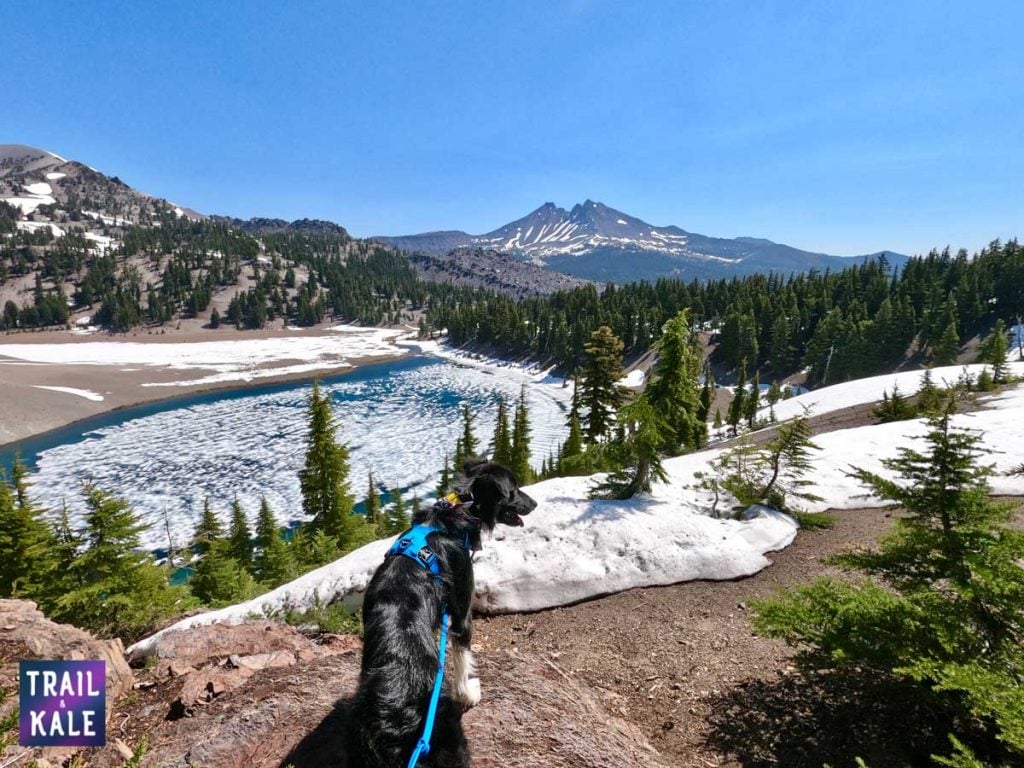

I am just starting to trail run with my Anita (who recently beat cancer! These tips are very helpful, especially on gear and massage. Thank you!
Hi Marnie, I’m so pleased you found them helpful – and congratulations to Anita for beating cancer! I hope you are able to run many glorious trail miles together 🙂